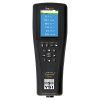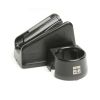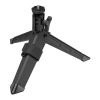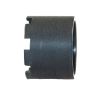YSI ProOBOD Optical BOD Probe
Features
- Probe body tapered to fit into a standard 300 mL BOD bottle
- User-replaceable, low-maintenance sensor with +1-year life
- Self-stirring to provide representative sample and improve response times
- Free ground shipping
- Expedited repair and warranty service
- Lifetime technical support
- More
Overview
The YSI ProOBOD optical BOD probe uses reliable luminescent technology with built-in self-stirring for highly accurate laboratory BOD measurements. The YSI ProOBOD luminescent BOD probe has built-in self-stirring to ensure a representative sample in the BOD bottle and to improve the response time. The optical sensor does not require a warm-up period, membrane changes, or electrode maintenance.
Optical Technology Stability
The greater stability of optical technology offers additional value by reducing drift and thus reducing costs associated with electrode maintenance and membrane changes. In addition, the technology is resistant to probe fouling from hydrogen sulfide and other gases. The smart, digital ODO probe stores calibration data, so probes can be interchanged between instruments without recalibration.
Benefits
- 2-year warranty
- Reliable and serviceable
- Probe body tapered to fit into a standard 300mL BOD bottle and international versions
- Extremely quiet operation
- No warm-up time required
- Probe Dimensions: 17cm length (6.7")
- Weight: 272 grams (0.60 lbs)
- Power: External 110-230 VAC, 50-60 Hz power supply with DC input to probe; U.S. and International receptacle
- Warranty: 2-year probe warranty; 1-year sensor cap warranty
- Cable: 3m (9 ft)
- Sensor Type: Optical (dynamic luminescence quenching lifetime detection)
- Flow Dependence: None - non-consumptive method (stirring will increase response time with no affect on accuracy)
- Ratings: RoHS, CE, WEEE, IP-65, Made in USA
- Response Time: T95 = 22 seconds with stirring; T95 = 40 seconds without stirring
- (1) ProOBOD probe
- (1) 6260 ProOBOD power supply
In The News
Spring 2025 Environmental Monitor Available Now
In the Spring 2025 edition of the Environmental Monitor, we highlight partnerships across the world and the importance of collaboration between government agencies, universities, environmental groups, local communities, and other stakeholders. From great white shark research in Cape Cod to monitoring fisheries in Lake Erie, this latest edition underscores partnerships that connect stakeholders in a watershed through environmental data. With an emphasis on data sharing, a combination of real-time and discrete sampling keeps the public and partners informed of environmental conditions. Our writers also sought out science professionals dedicated to working with peers within and outside of the environmental sector.
Read MoreMonitoring Mariculture in the Gulf of Alaska
The mariculture industry in the Gulf of Alaska has been steadily growing in recent years, guided by ongoing research to help refine farm location and cultivation practices. A subset of aquaculture, mariculture focuses on rearing organisms in the open ocean. In Alaska, finfish farming is illegal, so most farms cultivate kelp, oysters, or a combination of the two. These small, locally operated farms started popping up in the Gulf of Alaska in the early 1990s, when shellfish farming first became legal. Kelp farming did not begin to catch on in the state until 2016. Many of the coastal areas that have grown interested in mariculture are historically commercial fishing communities.
Read MoreSupplying Seattle’s Drinking Water: Using Data Buoys to Monitor the Cedar River Municipal Watershed
Providing clean, safe, and reliable drinking water for the 1.6 million people in the greater Seattle area is a top priority for Seattle Public Utilities (SPU). With limited water supplies, SPU dedicates considerable resources to maintain its watersheds and mountain reservoirs. About 70 percent of Seattle Water comes from the Cedar River Municipal Watershed , and the other 30 percent comes from the South Fork Tolt River Watershed . [caption id="attachment_39574" align="alignnone" width="940"] Data buoy in Chester Morse Lake . (Credit: Kevin Johnson / Seattle Public Utilities) [/caption] Jamie Thompson, a fisheries biologist at SPU, monitors aquatic ecosystems centered on fish listed under the U.S. Endangered Species Act (ESA).
Read More














